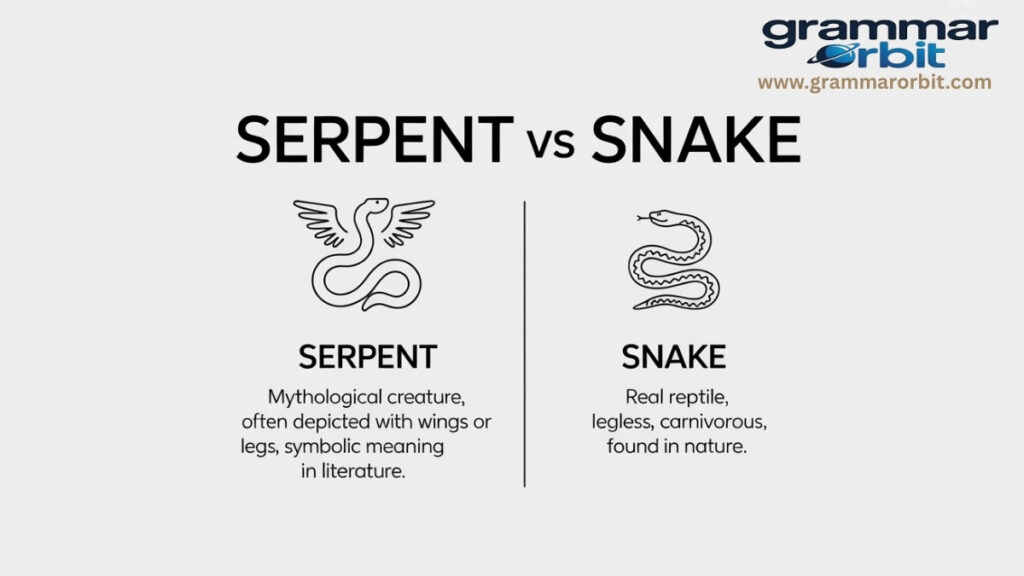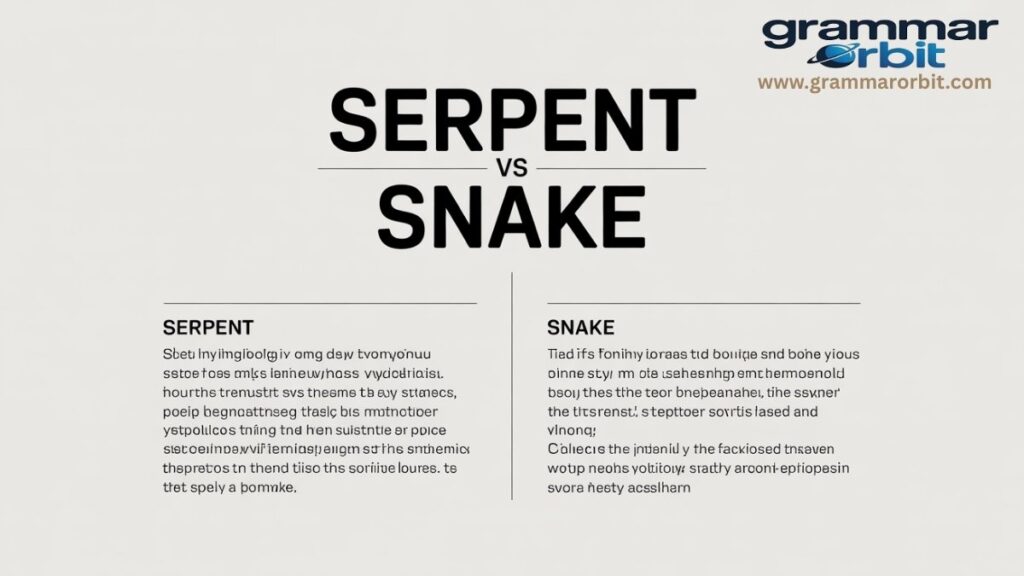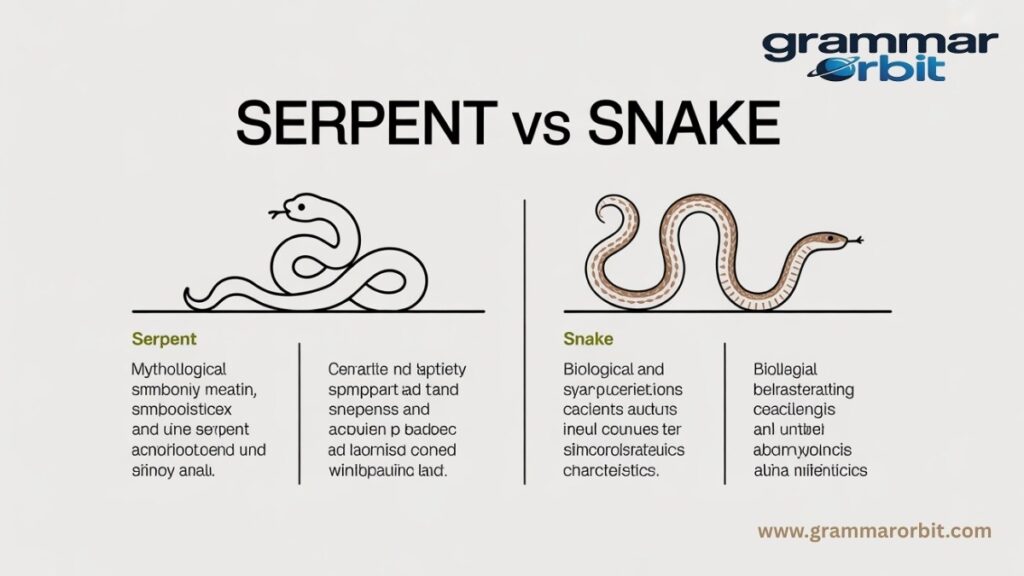Ever found yourself wondering if a serpent is just a fancy snake with a better publicist? You’re not alone. The “serpent vs snake” debate has been slithering through human history for centuries one lives in jungles, the other in mythology (and occasionally in bad dreams). Picture this: you’re watching a nature documentary, and the narrator suddenly says “serpent.” Instantly, you expect lightning, ancient curses, and maybe a dramatic soundtrack. Say “snake,” though, and you’re just thinking garden variety hiss and shed skin. So, what really separates the serpent from the snake besides a flair for drama? Let’s shed some light on this scaly mystery.
The Origin of the Words “Serpent” and “Snake”
Language carries the memory of human thought, and both “serpent” and “snake” have ancient roots that reveal how people once saw these creatures.
Etymology of “Serpent”
The word serpent originates from the Latin serpens, meaning “creeping thing.” It comes from the verb serpere, which means “to crawl” or “to creep.” The term entered English through Old French and was used to describe both literal snakes and mythological creatures with divine or sinister qualities.
From early religious texts to epic poems, the serpent meaning has always carried symbolic weight. It has represented mystery, wisdom, temptation, and transformation.
Etymology of “Snake”
The word snake comes from Old English snaca, rooted in the Proto-Germanic term for “creeping animal.” Unlike “serpent,” the word “snake” was never symbolic it was a straightforward description for the real reptile.
The etymology of snake reflects everyday language, practical and simple. Where “serpent” belonged to priests and poets, “snake” belonged to farmers and hunters.
Serpent vs Snake Etymology Summary
| Word | Origin | Meaning | Usage | Tone/Connotation |
|---|---|---|---|---|
| Serpent | Latin serpens (“to creep”) | Symbolic, mythical reptile | Myth, religion, literature | Mysterious, wise, or dangerous |
| Snake | Old English snaca | Real-life reptile | Science, daily use | Neutral or natural |
The serpent vs snake etymology tells a clear story: one belongs to myth and metaphor, the other to biology and fact.
Serpent vs Snake: The Core Difference

Here’s the truth: biologically, there’s no difference between serpent and snake. They refer to the same reptile group cold-blooded, limbless creatures covered in scales. But linguistically and symbolically, they couldn’t be further apart.
- Serpent: Represents a spiritual or mythological creature, often linked with mystery, evil, or wisdom.
- Snake: Represents the real, physical animal found in nature.
LKR Meaning in Text: What It Stands For and How to Use It
Serpent and Snake Difference in Context
| Context | “Serpent” | “Snake” |
|---|---|---|
| Religion and Mythology | Symbolic, often supernatural | Rarely used |
| Science and Biology | Not used | Standard scientific term |
| Literature | Poetic, allegorical | Literal or modern usage |
| Everyday Language | Archaic, formal | Common and simple |
To put it simply: every serpent is a snake, but not every snake is a serpent.
When you hear “serpent,” think mythology, religion, or literature. When you hear “snake,” think nature, science, and ecology.
Cultural and Symbolic Roles Through History

The serpent has slithered through centuries of human imagination, sometimes as a villain, sometimes as a symbol of wisdom and rebirth. Snakes, meanwhile, have played real world roles as predators, protectors, and sources of fear.
Serpents in Ancient Civilizations
- Ancient Egypt: The cobra, known as uraeus, represented divine authority and was worn on pharaohs’ crowns.
- Greece: The serpent was a symbol of healing. The Rod of Asclepius, with a coiled snake, remains a global symbol of medicine.
- Christianity: The serpent in the Garden of Eden tempted Eve, becoming the ultimate symbol of sin and deceit.
- Hinduism: The Nāga a half human, half-snake deity symbolizes fertility, protection, and spiritual power.
- Norse Mythology: Jörmungandr, the World Serpent, represented chaos, fate, and the endless cycle of life and death.
Snakes in Modern Culture
In modern times, snakes have traded some of their fearsome reputation for fascination.
- The medical caduceus features serpents as emblems of healing.
- Fashion brands like Versace and Bulgari use serpent imagery to convey beauty, luxury, and danger.
- Conservation movements highlight the vital ecological role of snakes in controlling pests and maintaining balance.
The snake cultural significance continues to evolve from a symbol of evil to an emblem of regeneration.
HWY Meaning in Text and Definition
Mythology vs Reality: Serpent Symbolism vs Snake Behavior

The serpent vs snake symbolism reveals a contrast between fantasy and fact.
Serpent Symbolism in Mythology
Mythological serpents appear in nearly every ancient story:
- The Ouroboros, a serpent eating its own tail, symbolizes eternity and renewal.
- The Biblical serpent embodies temptation and forbidden knowledge.
- The Hydra in Greek mythology stands for danger and the unstoppable nature of evil.
- Nāgas in Hinduism guard sacred treasures and waterways.
These legends gave serpents a complex identity sometimes divine, sometimes destructive. The serpent mythology meaning captures humanity’s oldest struggles with power, wisdom, and mortality.
Snake Behavior in Real Life
In contrast, real snakes are practical survivalists. They don’t guard temples or whisper to humans they hunt, hide, and adapt.
| Behavior | Real Snakes | Mythic Serpents |
|---|---|---|
| Movement | Slither and coil | Fly, swim, or encircle the earth |
| Defense | Camouflage, venom, hissing | Fire-breathing or god-like powers |
| Feeding | Swallow prey whole | Consume worlds or gods |
| Symbolism | Ecological and natural | Spiritual, moral, or cosmic |
The snake biology and behavior remind us that these creatures are vital to ecosystems. They keep rodent populations in check and even contribute to medical science through venom research.
Physical and Biological Distinctions
From a scientific standpoint, “serpent” has no place in classification. It’s purely literary. The biological term is snake, belonging to the suborder Serpentes within Reptilia.
Snake Anatomy and Adaptations
- Skeleton: About 200–400 vertebrae, making snakes highly flexible.
- Scales: Aid in movement and protection.
- Senses: Some species detect heat through facial pits.
- Venom: Used for hunting and defense.
Fact: There are more than 3,900 known species of snakes worldwide, from harmless garter snakes to deadly cobras and vipers.
Habitat and Adaptations
Snakes inhabit every continent except Antarctica. They’ve adapted to nearly every environment imaginable.
- Desert snakes like the sidewinder move in unique sideways motions to stay cool.
- Sea snakes can live entirely underwater.
- Tree-dwelling snakes use their tails for balance and grip.
These real-world adaptations likely inspired myths of serpents that ruled oceans, guarded treasures, or represented chaos. The serpent in ancient civilizations was often linked to water a symbol of creation and destruction.
FG Meaning in Text: Understanding Its Different Uses and Contexts
Serpents and Snakes in Language and Literature

Writers and poets have long used serpents to symbolize human traits like deceit, knowledge, or temptation.
- In the Bible, the serpent tempts Eve, representing sin and desire.
- Shakespeare used “serpent’s tongue” as a metaphor for treachery.
- In Milton’s Paradise Lost, Satan’s transformation into a serpent shows the corruption of purity.
- Virgil’s Aeneid portrays serpents as agents of divine punishment.
Common Serpent Phrases and Meanings
| Phrase | Origin | Meaning |
|---|---|---|
| Snake in the grass | 16th century | Hidden danger or betrayal |
| Serpent of wisdom | Esoteric writings | Knowledge and enlightenment |
| To shed one’s skin | Natural behavior | Personal transformation or renewal |
The serpent representation in literature reminds us how one reptile can symbolize both sin and salvation, depending on who’s telling the story.
Identifying Snakes: A Visual and Behavioral Guide

If you ever encounter a real snake, here’s what to look for.
Visual Features
- Head shape: Triangular heads often indicate venomous species.
- Pupil shape: Vertical slits suggest vipers; round pupils belong to non venomous snakes.
- Color patterns: Bright colors like red and yellow often signal danger.
Behavioral Traits
- Venomous snakes may stay coiled and defensive.
- Non-venomous snakes often flee or mimic dead behavior.
- Constriction snakes like pythons wrap around prey but rarely pose danger to humans.
| Trait | Serpent | Snake |
|---|---|---|
| Nature | Symbolic, mythical | Biological, real |
| Habitat | Mythic realms | Forests, deserts, oceans |
| Behavior | Supernatural | Natural and observable |
| Cultural Role | Religious, moral, poetic | Ecological and scientific |
This serpent and snake comparison chart shows that one belongs to storybooks, the other to the living world.
Modern Interpretations: From Fear to Fascination
The modern world has redefined how we see snakes.
- Ecological Role: They keep ecosystems healthy by controlling pests.
- Medical Research: Snake venom has led to breakthroughs in heart and blood treatments.
- Cultural Shift: Snakes now symbolize resilience and rebirth rather than pure evil.
Even today, the serpent spiritual meaning persists. The act of shedding skin still represents transformation and new beginnings.
Reference: Cambridge Dictionary Definitions
Here’s a trusted source for clear word meanings:
Key Takeaways: Serpent vs Snake Meaning
- The difference between serpent and snake lies in language, not biology.
- “Serpent” is poetic and symbolic; “snake” is scientific and literal.
- Myths made serpents symbols of power, wisdom, and danger.
- Snakes play vital roles in ecosystems and medicine.
- Understanding the two deepens our appreciation of both nature and culture.
FAQs
What is the difference between Serpent vs Snake?
The serpent is a symbolic or mythological version of a snake. Scientifically, there’s no biological difference.
Are serpents real or mythical?
Both. Serpents can describe real snakes in a poetic sense, but mythological serpents often have supernatural traits.
Why is the serpent used in the Bible?
It symbolizes temptation, cunning, and forbidden knowledge, making it a fitting metaphor for the fall of man.
Can serpent and snake be used interchangeably?
In casual use, yes. But in writing, “serpent” suggests symbolism or myth, while “snake” refers to the real reptile.
Conclusion
So, after slithering through myths, languages, and legends, we’ve finally untangled the great “serpent vs snake” mystery. Turns out, the difference isn’t about scales or fangs it’s about attitude and storytelling. A snake minds its own business, hunting frogs and sunbathing. A serpent, on the other hand, stars in ancient tales, whispers in forbidden gardens, and occasionally threatens gods. In short, every serpent is a snake, but not every snake has the dramatic flair to be a serpent. So next time someone mentions a serpent, remember it’s just a snake with better branding and a flair for the theatrical.
JHON AJS is an experienced blogger and the creative voice behind the website grammarorbit.com, namely Grammar Orbit. With a keen eye for language and a passion for wordplay, he creates engaging grammar insights, word meanings, and clever content that make learning English enjoyable and interesting for readers.






